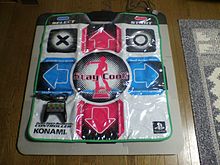Dance mat
A dance mat is a special game controller for controlling dance games . There are different versions for various game platforms ( game consoles , PCs and arcade machines ).
Dance mats were known primarily for the arcade game Dance Dance Revolution (DDR abbreviated - is in Europe under the name "Dancing Stage" expelled), which in 1998 by Konami was put on the market.
construction
Dance mats for single players are usually divided into nine (3 × 3) pressure-sensitive fields, the outer fields are provided with arrows in the appropriate directions from the center. The middle field serves as the starting position for the player, the other fields must be touched or entered by the player during the game. Some dance mats also include the middle field in the game using sensors. In addition, there is often a “Select” and a “Start” field, which correspond to the corresponding buttons on commercially available gamepads and are used to control the game menu.
use
The dance mat games almost all follow the same concept: a screen displays arrows at the top of the screen that correspond to those on the dance mat. While music is playing, arrows move up from the lower part of the screen - if these (in rhythm with the music) are congruent with the above, the player must enter the corresponding field. If the arrow pulls a "tail" after it, the player must hold the field down for a correspondingly long time. Points are awarded depending on the timing of the target. If too many fields are not entered correctly, the game is lost. Common increases in difficulty are increasing the number of steps to be performed and the occurrence of more complicated combinations.
Types of dance mats
Dance mats (more like dance platforms) of arcade games are made of metal and have fields as arrows that light up accordingly. There is also often some kind of railing that the player can hold on to.
In contrast, dance mats for home use usually consist of plastic mats ("soft pads"). The lower price segment starts with the cheapest versions at around 15 euros. However, these mats are poorly suited for regular players, as they can easily slip or fold over during play and wear out quickly.
Mats from the middle price segment (starting at around 30 euros), which are lined with foam, are slightly higher quality.
For the ambitious home dancer, there are also metal platforms, similar to those found in arcade machines. These (“hard pads”) have a significantly higher price, starting at around 100 euros.
Dance mats for home use are mainly designed for consoles, but can be converted using a converter such. B. can be connected to PCs via USB . Older converters in particular have problems with the axis assignment. Some newer converters allow you to explicitly switch to a mode for dance mats, for example by holding down the key combination "Up, Start, Select" for three seconds. Other models for PC are equipped with a USB connection or with a keyboard PS / 2 connection.
Web links
- Well-known dance mat manufacturers: MayFlash Europe , Impact Pro , Cobalt Flux , RedOctane ( Memento from January 6, 2009 in the Internet Archive ), Logic3 ( Memento from March 1, 2000 in the Internet Archive ), 2-Tech
- StepMania : Free open source DDR clone for PCs ( Windows / Mac OS X / Linux, etc.)
- In The Groove : DDR clone for machines, PCs (Windows + Mac) and game consoles with calorie counter
- pydance (formerly pyddr): Free open source DDR clone for PCs ( Python , various operating systems )


